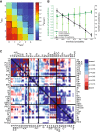A predictive model of the cat cortical connectome based on cytoarchitecture and distance
- PMID: 25062666
- PMCID: PMC4575693
- DOI: 10.1007/s00429-014-0849-y
A predictive model of the cat cortical connectome based on cytoarchitecture and distance
Abstract
Information processing in the brain is strongly constrained by anatomical connectivity. However, the principles governing the organization of corticocortical connections remain elusive. Here, we tested three models of relationships between the organization of cortical structure and features of connections linking 49 areas of the cat cerebral cortex. Factors taken into account were relative cytoarchitectonic differentiation ('structural model'), relative spatial position ('distance model'), or relative hierarchical position ('hierarchical model') of the areas. Cytoarchitectonic differentiation and spatial distance (themselves uncorrelated) correlated strongly with the existence of inter-areal connections, whereas no correlation was found with relative hierarchical position. Moreover, a strong correlation was observed between patterns of laminar projection origin or termination and cytoarchitectonic differentiation. Additionally, cytoarchitectonic differentiation correlated with the absolute number of corticocortical connections formed by areas, and varied characteristically between different cortical subnetworks, including a 'rich-club' module of hub areas. Thus, connections between areas of the cat cerebral cortex can, to a large part, be explained by the two independent factors of relative cytoarchitectonic differentiation and spatial distance of brain regions. As both the structural and distance model were originally formulated in the macaque monkey, their applicability in another mammalian species suggests a general principle of global cortical organization.
Keywords: Anatomical tract tracing; Cerebral cortex; Connectivity; Cytoarchitecture; Neuroinformatics.
Figures










References
-
- Bailey A, Ombuki-Berman B, Ventresca M (2013) Automatic inference of hierarchical graph models using genetic programming with an application to cortical networks. In: Blum C (ed) GECCO’13: Proceedings of 15th annual conference on genetic and evolutionary computation. ACM, New York, pp 893–900
Publication types
MeSH terms
LinkOut - more resources
Full Text Sources
Other Literature Sources
Research Materials
Miscellaneous

